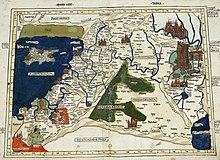
Back Vrugbare Halfmaan Afrikaans الهلال الخصيب Arabic الهلال الخصيب ARZ Creciente Fértil AST Bərəkətli hilal Azerbaijani برکتلی هیلال AZB Бәрәкәтле ярым ай Bashkir Урадлівы паўмесяц Byelorussian Урадлівы паўмесяц BE-X-OLD Плодороден полумесец Bulgarian


The Fertile Crescent (Arabic: الهلال الخصيب) is a crescent-shaped region in the Middle East, spanning modern-day Iraq, Israel, Jordan, Lebanon, Palestine, and Syria, together with northern Kuwait, south-eastern Turkey, and western Iran.[1][2] Some authors also include Cyprus and northern Egypt.[3][4]
The Fertile Crescent is believed to be the first region where settled farming emerged as people started the process of clearance and modification of natural vegetation to grow newly domesticated plants as crops. Early human civilizations such as Sumer in Mesopotamia flourished as a result.[5] Technological advances in the region include the development of agriculture and the use of irrigation, of writing, the wheel, and glass, most emerging first in Mesopotamia.
- ^ Haviland, William A.; Prins, Harald E. L.; Walrath, Dana; McBride, Bunny (13 January 2013). The Essence of Anthropology (3rd ed.). Belmont, California: Cengage Learning. p. 104. ISBN 978-1111833442.
- ^ Ancient Mesopotamia/India. Culver City, California: Social Studies School Service. 2003. p. 4. ISBN 978-1560041665.
- ^ "Countries in the Fertile Crescent 2024".
- ^ Quam, Joel; Campbell, Scott (31 August 2022). "North Africa & the Middle East: Regional Example – The Fertile Crescent".
- ^ The Editors of Encyclopaedia Britannica . "Fertile Crescent". Encyclopædia Britannica. Cambridge University Press. Retrieved 28 January 2018.